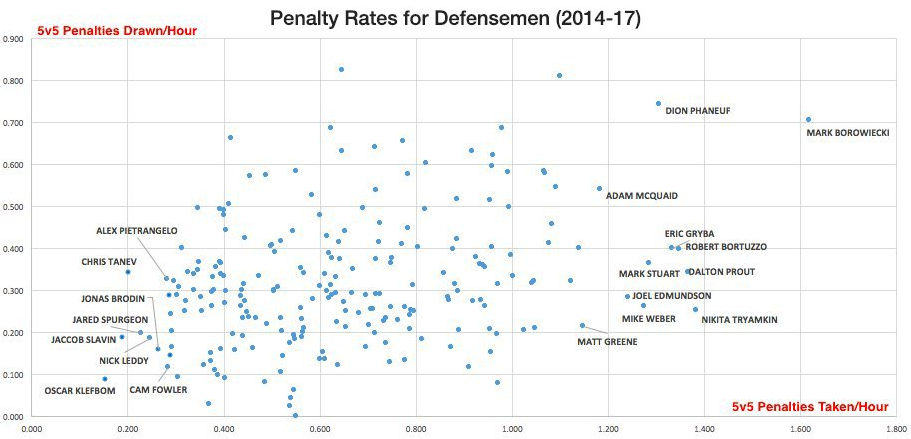On the surface it may have looked like a normal sequence, one of the many that take place over the course of a typical NHL game. But when Oscar Klefbom lost his angle on a Max Domi net-drive on Feb. 14 and had to haul down the young, dynamic Coyotes forward, the result actually marked a rather noteworthy event.
After 56 games, and north of 1,200 all-situation minutes (roughly 1,000 of which came during five-on-five play), the ‘holding’ infraction Klefbom was dinged with was the first penalty he’d been called for in the 2016-17 season. He went on to get called for another tripping penalty against Marcus Johansson a few games later, but those four minutes are still the only ones he’s spent in the box to-date this season.
This is nothing new for Klefbom, who has arguably been the league’s most disciplined defender ever since he joined the NHL. Here’s a look at the rate at which every NHL defenceman with at least 1,000 minutes played at five-on-five since the 2014-15 season has taken and drawn penalties:

The dichotomy between the different player types listed at either end of the spectrum here is fairly telling and provides us with a worthwhile opportunity to segue into a deeper discussion about the way we evaluate defencemen in general.
It’s no secret that as the game has evolved, the defence position has changed more than any other as they try to keep up with the increased pace.
Not too long ago defence was a position littered with slow, lumbering giants whose defining traits were their punishing physicality and their uncanny ability to block shots. Those archetypes have been phased out for the most part and largely replaced with players who can either skate like the wind, move the puck quickly and on target, or ideally some combination of the two. You can visually see this delineation on the chart above, with the old-type on the far right and the new-type on the far left.
With teams looking to play at a faster pace to generate offence and keep their opposition off balance, having the horses to make those transitions from one end of the ice to the other as seamless as possible is paramount. There’s no question that because of that the progression of the position has been a net positive. The players are better and more skilled than ever before, and the game is benefitting from an aesthetic perspective.
The only problem, however, is that I’m dubious that our ability to properly capture the impact and contributions of those players has kept up with the advancements of the position itself. Beyond looking at scoring (which is flawed considering most defencemen have trouble separating themselves from the rest of their peers), and team on-ice shot rates (which are more nuanced, but still subject to various contextual usage factors that muddy the waters), there’s still an extra layer for us to peel back down the line.
This is where the ongoing work of someone like Corey Sznajder is instrumental, as his extensive tracking project provides us with a greater understanding of the mechanisms of what’s actually happening on the ice schematically. Hopefully through his labour of love – and the league-wide tracking data that’ll hopefully one day be made publicly available – we’ll get more insight about the how and why.
The reason why talent evaluators swing and miss as often as they do on defencemen is because the act of defending is a tantalizingly difficult one to define and quantify. In theory, the most effective defensive play is the one that’s never captured statistically because nothing technically happened. A player who’s able to read the play and be in the right position at the right time will, more often than not, prevent an action from ever materializing in the first place.
I suspect this is why players such as Klefbom and his peers Chris Tanev, Jaccob Slavin and Jared Spurgeon appear so favourably on this chart. Despite not necessarily putting up huge counting numbers, or looking like conventionally great defenders on the surface, they’ve all been successful because they’re smart, positionally sound, and limit their mistakes. They hardly ever take penalties because they don’t make a habit of wildly chasing the play and instead stay in control at all times. [snippet]
That’s where penalty data surely provides some neat hidden value. With how difficult it is to consistently score at even strength, every single opportunity to play with a man advantage is pivotal. Considering that teams are converting 19 per cent on the power play on average, every five or so opportunities is worth an extra goal, which adds up over time.
It could just be a happy coincidence, but it shouldn’t be lost on anyone that the Hurricanes take the fewest penalties. After all, a current member of their own staff was breaking ground on this topic years ago, looking at the value of players with positive penalty differentials.
Maybe most important in those findings is he showed that a defenceman’s discipline or lack thereof is a repeatable skill that tends to carry over from one season to the next. There’s a reason why defenders who routinely manage to stay out of the box are as effective as they are without the puck — and there’s certainly something insightful about their defensive prowess to be gleaned from why they’re able to do this and others aren’t.
It’s funny to think about how far we’ve come. There may have been a time not too long ago when these skilled defencemen would’ve been mischaracterized as being soft for how they play, rather than praised.
[relatedlinks]









